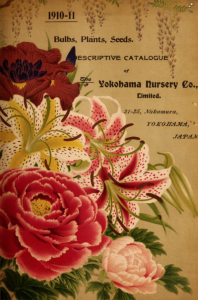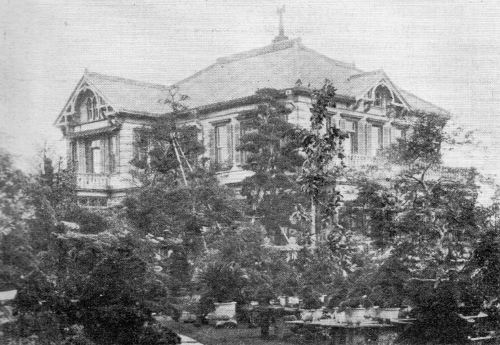Yokohama Nursery Co., a Century Later
That coat. I knew it at first glance.
In Yokohama to do research for my book on Eliza Scidmore, I took a bus across town Friday morning to attend a ceremonial planting of dogwood trees at Honmoku Sanchou Park.
The trees were among 3,000 dogwood saplings that America gave to Japan last year in exchange for Japan’s gift of 3,000 cherry trees to Washington a century ago.
The mayor of Yokohama and the U.S. ambassador to Japan attended the event. But what caught my eye throughout the ceremony was the back of the Japanese gentleman who took the seat in front of me. He was wearing an indigo-blue cotton coat emblazoned with the words “The Yokohama Nursery Co.” Turns out he was the company’s executive vice president, Kazua Ariyoshi.
I remembered seeing a photo of that coat — or one very much like it — in David Fairchild’s memoir The World Was My Garden.
Scidmore Ally
David Fairchild was a botanist at the U.S. Department of Agriculture at the turn of the century. He traveled the world seeking different kinds of edible and ornamental plants to import to the United States.
During a trip to Japan in 1902 Fairchild learned about the country’s flowering cherry trees and their beautiful blooms. He imported several varieties in 1906. He wanted to introduce them into American horticulture but needed to test their growing conditions first, so he planting some at his country home just outside Washington, D.C.
Those experimental trees helped pave the way to the Japanese cherry trees in downtown Washington, planted in 1912. Eliza Scidmore, David Fairchild and his wife, and First Lady Helen Taft all had a hand in bringing that about.
In his book, Fairchild described visiting the Yokohama Nursery Co. and the friendship he developed with one of the owners, Uhei Suzuki.

Yokohama Nursery Co. catalog, 1910-11 (Source: Gardens Trust blog)
The nursery, founded by a coalition of gardeners in 1893, did a booming business shipping plants to buyers in the West. It had branch offices in New York and London. The company’s most popular export was lily bulbs, but it also provided many other plants, including shrubs, ferns and trees.
Eliza Scidmore visited the nursery during her frequent travels to Japan. She wrote a lot about the Japanese passion for flowers, gardens and nature.
I’ve seen evidence of that trait everywhere in Japan during my trip here. Scidmore described the Japanese as “necromancers” who seemed to coax something magical from plants.
Blue Jackets and Kimonos
During his visit to the Yokohama Nursery, Fairchild was taken with its “charming” operations:
“The packing sheds presented a beautiful and animated scene, peopled by a hundred or more women dressed in bright blue kimonos with figured blue-and-white handkerchiefs about their heads and white socks and wooden sandals on their feet. Fern balls were then a fad in America; half a million were shipped from Japan to New York and London annually, and these blue-clad women were busy making them. The men were dressed in rather elaborate blue jackets. On the back of each was an enormous white circle in which was stenciled the company’s name in Japanese characters.”

Yokohama Nursery Company’s main office in Yokohama, c. 1908 (Source: Peter Del Tredici, “From Temple to Terrace,” Arnoldia; Arnold Arboretum, Harvard)
Arrayed on the nursery’s long pine tables were dwarfed trees (bonsai), larger trees in blue and white porcelain pots decorated with figures, tiny maples in green porcelain containers no larger than a teacup.
Fairchild scrambled around the place snapping away with his camera. “It seemed incredible,” he wrote, “that a nursery could be so picturesque.”
Over the years the Yokohama Nursery has won many international awards for its plants. And the company is still in business today.

